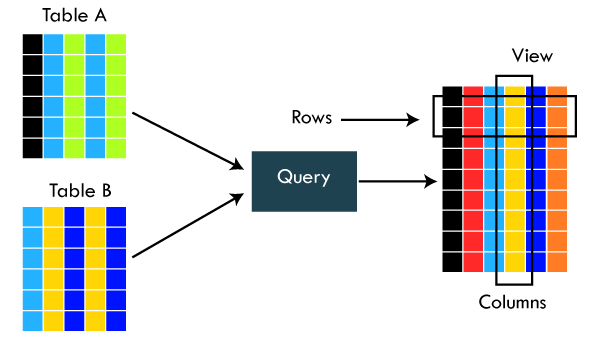SQL views
SQL views are virtual tables that are based on the result set of a SQL SELECT statement. A view is essentially a saved query that can be used like a table in SQL queries, but it doesn't actually store any data itself. Instead, it retrieves its data from one or more tables or other views.
Here are some of the key features and benefits of SQL views:
- Simplify complex queries: Views can simplify complex queries by breaking them down into smaller, more manageable parts. By creating a view that retrieves the data needed for a particular task, you can simplify the queries that use that view.
- Provide a layer of abstraction: Views can provide a layer of abstraction between the physical tables and the users or applications that access them. By presenting a simplified view of the data, views can make it easier for users and applications to work with the database.
- Control data access: Views can be used to control access to sensitive data by limiting the columns and rows that are exposed to specific users or roles. By creating views that only show the necessary data, you can prevent users from accessing data that they shouldn't see.
- Improve performance: Views can improve query performance by precomputing the results of complex queries and storing them in a view. This can save time and resources by eliminating the need to recompute the same data each time the query is run.
- Enable modular design: Views can enable modular database design by breaking the database into smaller, more manageable parts. By creating views that encapsulate the logic for a particular part of the database, you can make it easier to modify and maintain the database over time.
SELECT column1, column2.....
FROM table_name
WHERE [condition];
The WITH CHECK OPTION clause is used in SQL to ensure that all data modifications (inserts, updates, and deletes) made through a view meet certain criteria. When the WITH CHECK OPTION is used, the database system checks to make sure that all data modifications made through the view satisfy the specified conditions. If a modification violates the condition, the modification is rejected and an error message is returned.
SELECT name, age
FROM CUSTOMERS
WHERE age IS NOT NULL
WITH CHECK OPTION;
The WITH CHECK OPTION in this case should deny the entry of any NULL values in the view's AGE column, because the view is defined by data that does not have a NULL value in the AGE column.
A view can be updated under certain conditions:
- The SELECT clause may not contain the keyword DISTINCT.
- The SELECT clause may not contain summary functions.
- The SELECT clause may not contain set functions.
- The SELECT clause may not contain set operators.
- The SELECT clause may not contain an ORDER BY clause.
- The FROM clause may not contain multiple tables.
- The WHERE clause may not contain subqueries.
- The query may not contain GROUP BY or HAVING.
- Calculated columns may not be updated.
- All NOT NULL columns from the base table must be included in the view in order for the INSERT query to function.

Комментарии
Отправить комментарий